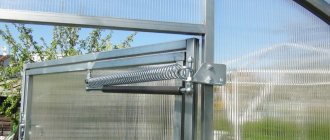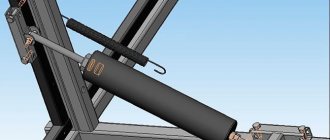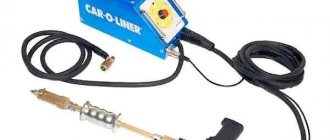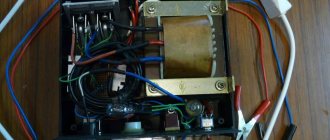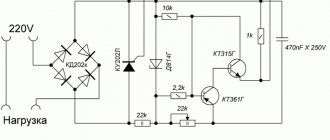Growing plants indoors requires creating an optimal microclimate. To do this, you need to ensure not only proper watering, but also ventilation. Unfortunately, it is not always possible to constantly control ventilation in a greenhouse. But, if you don’t want to destroy the crop, a thermal drive for greenhouses is an excellent way out of the situation - a device that will automatically open and close the ventilation holes.
You can buy a ready-made device, but to save money, we suggest making a thermal drive for greenhouses with your own hands from scrap materials, using theoretical information and practical tips from our article.
- From an office chair and other materials
Types and methods of ventilation of greenhouses
There are two types of ventilation in greenhouses: natural and forced. Natural involves ventilation using vents, transoms, and doors. Forced operation uses fans that provide air inflow and outflow.
Timely ventilation contributes to a great harvest
Advantages and disadvantages of manual ventilation
The easiest way to ventilate: if it’s hot, open the windows, if it’s cold, close them. The advantage of the manual system is that it is economical, but there is an unexpected complication. Draft negatively affects the development of any plants.
Another disadvantage is the need for constant presence. What if the greenhouse owner only comes for the weekend? The only way out is an automatic greenhouse ventilation system, created with your own hands, which will give you the opportunity to be away on your own business.
Manual ventilation requires constant attention
If the greenhouse has correctly positioned windows, it is easy to “teach” them to open and close without your participation.
Automatic ventilation and its types
The automatic system provides the following advantages:
- the windows open during a given temperature increase and to the desired height;
- For each crop, different climatic conditions can be created.
All automatic ventilation devices are divided into 4 categories:
- Hydraulic mechanisms.
- Bimetallic system.
- Automated windows.
- Ventilation using electrical appliances.
Attention! The air inflow into the room must be equal to the outflow. This requires transoms located on both sides of the greenhouse, at different distances from the floor.
Automatic ventilation – some advantages
Hydraulic ventilation
The greenhouse uses the basic principle of hydraulics: when heated, the liquid expands, and when it cools, it contracts.
In self-made automatic greenhouse ventilation systems, practitioners use air or water, which expands and pushes a piston. That, in turn, moves the rod that raises the transom. Let's consider 2 automation options. The first is a thermal drive from a hydraulic cylinder using air expansion. The second is a system of plastic bottles or glass jars with water.
Hydraulic ventilation is the most complex of all types
Classification of thermal actuators
Based on the mechanisms of action, the following types of devices are distinguished:
- Electric – the drive is driven by an electric motor. The signal is supplied by the controller, which interacts with the temperature sensor. They are characterized by high power, as well as the ability to form intelligent systems that control automatic ventilation. At the same time, they are vulnerable to high humidity. The relative high cost and the need for power supply are factors limiting their use.
- Pneumatic - the working element is heated air, which drives the piston. For the drive to work, it is necessary to recreate the complete tightness of the container. Achieving this in artisanal conditions is not easy.
- Bimetallic - different expansion coefficients when heating the metals used are the basis of their functioning. The models are simple and convenient, but limited in power.
- Hydraulic - operation is carried out as a result of fluctuations in the weight of two containers with moving liquid due to changes in the pressure of the air mixture with temperature fluctuations. The drives are characterized by significant power and ease of assembly.
Reliable automation with pneumatic drive
You can equip automatic ventilation of greenhouses with your own hands. The simplest option is a pneumatic drive from a hydraulic cylinder.
List of required materials
For installation you will need a couple of days, tools and several components:
- a piece of plastic pipe in the form of a cylinder with a length of 300-350 mm and a diameter of 200 mm;
- a piece of plexiglass with a thickness of 5 mm;
- wooden stick for making a rod;
- soccer ball camera;
- thin hose 1.5 - 2 m long.
Attention! A plastic pipe can be replaced by any cylinder made from scrap materials. For example, from polycarbonate left over after installing a greenhouse or greenhouse.
Pneumatic greenhouse ventilation
Preparing to install the cylinder
- Take a pipe and make two sealed plexiglass plugs for it. The top one will serve as a guide for the rod.
- Make a piston from plexiglass. It should be 1-2 mm smaller than the internal diameter of the cylinder.
- The rod is made of wood or a piece of plastic pipe (size 32). If you choose the wooden option, then a stick 500 mm long and 40 mm in diameter needs to be sanded and coated with an antiseptic.
- Drill holes in both plugs. On the bottom – with a diameter of 10 mm. On the top - such that the rod fits in it.
Manufacturers
Do-it-yourself rack: options and diagrams on how to make a high-quality rack quickly and easily
Now let’s make a short review of products for ventilating greenhouses from various companies. There are a number of automatic devices on sale today that operate on the various principles mentioned above. Any model that will be described is quite easy to install yourself. But if we are talking about electrical solutions, then it would still be better to contact a specialist.
"Dusya San"
So, the first option I want to talk about is “Dusya San”. This option uses a thermal cylinder operating on a hydraulic principle. This model operates at a temperature of no more than fifty degrees. The weight of the largest window that this device can open is seven kilograms. The machine is sold fully equipped, in addition to it comes with installation instructions.
Installation can be performed in various greenhouses. The main thing is that the window works clearly both for closing and opening. The opener does not require batteries or an electrical connection. In this case, the ventilator can be easily adjusted to open the window in the required temperature range. If the temperature rises to 30 degrees, then the window opens all the way.
"Sesame-M-2015"
Another interesting option is called “Sesame-M-2015”. The main element of this system is a hydraulic cylinder filled with oil. This model works over a wide temperature range and can be easily adjusted. The weight of the product is only one kilogram, but this is enough for the thermostat to easily open heavy oversized windows and doors. To avoid false operation of the system from overheating, you can protect it by installing special umbrellas on the street side.
"Thermal drive"
The next model is “Thermal Drive”. This development of a domestic manufacturer from Krasnoyarsk can open a window or door weighing up to twenty kilograms. But it is better to use it on window and door structures weighing up to ten kilograms. The largest opening angle is 45 degrees.
This design works using a hydraulic-type thermal cylinder. The manufacturer provides a twenty-year warranty on its products. It is quite simple to install such a system yourself - the instructions contain a similar installation diagram for this model.
Open Planet
Another solution that I would like to talk about is called Open Planet. The manufacturer guarantees that this device creates an ideal microclimate in the greenhouse for cultivating plants. Thanks to it, the temperature in the greenhouse can be adjusted in the range from 15 to 25 degrees.
This model has a reinforced structure with two springs, which makes it possible to use it not only on windows, but also on doors. The car ventilator is made of stainless steel. But in the cold season it is better to dismantle it so that the cylinder does not become deformed.
Pneumatic cylinder assembly
- Glue the bottom plug to the cylinder.
- Place the ball chamber inside, tightly connected to the hose.
- Pass the hose through the plug. Secure the rod in the center of the piston. Insert the piston into the cylinder so that it presses the ball.
- Pass the rod through the top plug and seal it tightly to the cylinder.
Advice . If you secure the guide with tape, you can remove it and service the device in case of a malfunction.
The pneumatic cylinder, created from a hydraulic cylinder, is completely ready. When air flows through the hose, it will inflate the ball, which will lift and push the piston and rod.
Stages of work on installing the receiver
The assembled part is only half of the automatic ventilator. For it to work properly, you need to connect the hydraulic cylinder to a container with air, that is, to the receiver. The larger the receiver, the higher the air pressure inflating the ball.
Receiver from a canister
A large paint can or canister with a capacity of 20 liters is suitable as a container for air. The main thing is that they are hermetically sealed.
- At the bottom of a tightly closed canister, you need to install two pipes.
- Connect one of them tightly to the hose entering the hydraulic cylinder.
- On the second, put a piece of hose 100-150 mm long. Pump air into it and turn it off when the rod extends a little.
The receiver is ready! When the air pressure increases, it flows through the pipe into the hydraulic cylinder, and the rod opens the transom, providing automatic ventilation of the greenhouse.
How to properly install a finished mechanism
The automatic device should be connected to one window that opens along a horizontal axis. It is important to install the receiver so that it is not exposed to sunlight. It is best to hang it under the roof of the greenhouse, covering it with foil or other protective screen.
The pneumatic drive connected to the receiver should be installed next to the window. A rod attached to the window will raise the frame as soon as the greenhouse gets hot. And it will go down when it gets cold.
The invention should be calibrated by adjusting the pressure inside the system using a free hose. Calibration allows you to achieve the opening and closing of the window at a certain temperature.
Advantage of the device: the unit can be constructed independently from scrap materials.
Minus: the hydraulic cylinder is designed for light horizontal transoms.
How to use commercial water seals on a jar - instructions
You can purchase factory-made water seals for wine fermentation both in specialized stores and online. Several types of devices are available.
A two-chamber valve consists of a curved tube with two thickenings. Water is poured into them. There is a rubber seal at the end to ensure the water seal is sealed.
Manufacturers also offer a collapsible design, consisting of two elements that are inserted according to the principle of a smaller chamber into a larger one. The use of purchased water seals gives good results.
The purchased water seal must be carefully inserted into the previously prepared hole in the lid and ensure its tight closure (silicone, plasticine, etc.). Water is poured in and the device begins to work.
Automatic ventilation by bank method
Ventilation in a greenhouse is not difficult to do with your own hands, even if there are no pipes, pieces of wood or plexiglass. Just two glass jars are enough and the window will open on its own.
Materials for making automation from cans
Advice. Following the example of glass jars, you can make a system from plastic bottles with a capacity of 5 liters. and 800 ml.
Installation of a banking device requires the availability of available materials:
- 2 glass jars (3 l, and 800 ml);
- 1 metal cover;
- 1 polyethylene cover;
- brass or copper tube 300 mm long and 5 mm in diameter;
- medical IV tube 1 m long;
- a wooden beam for counterweight, similar to the size of the frame;
- 2 nails 100 mm;
- wire;
- sealant.
Automatic can ventilator
Installation of a two-can system
When all the necessary components and tools are ready, you can proceed:
- Pour 800 ml into a three-liter jar. water. Roll up with a metal lid.
- Drill a hole in the lid and insert a brass tube into it, so that it does not reach the bottom of the jar by 2-3 mm. Secure the tube and seal the joint with sealant.
- In a jar with a capacity of 800 ml. you should pour 200 ml. water, close the lid. Make a hole in the plastic lid and insert the tube from the dropper into it, not reaching the bottom by 2-3 mm.
- Nail a wooden beam onto the lower frame outside the window. Secure the smaller jar to the upper frame with a nail and wire. Attach a large jar higher or place it on a shelf above a small jar. The device is ready!
Now, as soon as the air in the dish heats up, it will displace water from a three-liter jar into a small one. The smaller container will become heavier, drop down and open the window. And vice versa.
The advantage of automatic ventilation is that it is easy to make and does not require any material costs.
Disadvantages of the device:
- suitable only for windows opening along a horizontal axis;
- Periodically you need to add evaporated water.
Making your own ventilator
Since some of the devices described above have a fairly simple design, it is quite possible to organize greenhouse ventilation with your own hands.
Multi-tank system
Two-tank system
This homemade device consists of two containers - large and small. The larger one is made of metal and filled with oil. The liquid, heating up, flows into a smaller container to which a window is attached, and the latter begins to gradually open.
- For a larger container, you can use a metal canister with a capacity of 3-4 liters. The smaller one can be made from an ordinary tin or glass jar.
- To make tubes through which liquid will flow from one container to another, you can use any material. The main thing is that the tubes are long enough and reach the bottom of the container.
- If the tubes are metal, then a welding machine is used to attach them to the canister. Rubber or plastic tubes are secured with threaded nuts.
- A larger container is filled with working fluid, for example, used automobile oil, by approximately 35-40%.
- A small container is filled completely with liquid, and the tube that is connected to it should be filled with oil approximately 1 cm above its level.
- A small container is installed on the edge of the window outside. The large one is mounted under the ceiling inside the greenhouse.
The tubes connecting the two tanks must fit into them tightly! Otherwise, the system will not work.
When the outer container heats up under the sun, the oil will begin to flow into the container located in the greenhouse. It will fall down under the force of gravity, and the window will open, thus creating ventilation in the greenhouse.
When the temperature drops, the oil will flow back, the outer container will become heavy and its weight will force the window to close.
Pneumatic system
Automatic pneumatic ventilation diagram
To make a pneumatic ventilator for a greenhouse with your own hands, you need to prepare:
- Metal canister.
- A small cylinder with smooth walls.
- Inflatable ball.
- A piece of foam.
- Silicone sealant.
- Metal rod.
- Rubber tube.
- 2 meters of strong fishing line.
- A bobbin from a sewing machine.
- A small metal strip.
- Glue.
- Scotch.
An example of a homemade pneumatic system for ventilating a greenhouse
A do-it-yourself pneumatic ventilation system is somewhat more difficult to manufacture compared to the previous method, but the operation of this device is also based on the use of thermal energy. First of all, you need to paint the canister black so that it better attracts the sun's heat. When the paint has dried, drill a hole in the cover for the connecting hose and insert the hose itself, securing it tightly with sealant.
To make a smaller container, a piece of polycarbonate is used, rolled into a tube, the end ends of which are glued together with cyanoacrylic glue. The bottom and cover of the cylinder are also made by hand from polycarbonate. You need to drill a hole in the bottom for the tube, and a hole for the rod in the lid. To make a guide, you can use a regular plastic tube of the required diameter.
Next, a ball is put on the tube and hermetically fixed to it. A round piston is cut out of foam plastic, and its sides are covered with tape for good gliding. Then a rod made of metal is attached to the foam piston.
A rocker arm with two different holes at the ends is made from the plate. The hole of the larger diameter is used for fastening to the axle, and the smaller one is used for attaching an additional bowstring. The axle is made from a regular nail.
This DIY ventilation system works quite simply. The air in the receiver, fixed under the ceiling of the greenhouse, moves into the cylinder when heated, which helps inflate the balloon. At the same time, the piston with the rod rises, acting on the rocker arm, tensioning the fishing line and raising the window. When the air cools down, the window closes.
Bimetallic ventilation system in action
Operating principle of a bimetallic device
Metals, like liquids, expand when heated. From them, it is also possible to install a ventilation system for heifers, which operates on the difference between the expansion coefficient of two metal strips. A simple and effective device - an automatic device for ventilating a greenhouse made of boards and metal
Attention! Any automation needs protection from direct sunlight. The mechanism should be heated not by the sun, but by the air.
To build the device you will need:
- wooden beam;
- board;
- metal strip;
- nails;
- hinge.
Sequencing:
- The metal sheet and board should be fixed vertically to the floor.
- Insert a wooden beam in the middle between them.
- Fasten the entire structure.
- Attach the metal strip to the window using a hinge. Ready!
Metal that responds quickly to increased temperature will flex and open the frame under the force of expansion. Once the sheet cools, it will return to its original state.
The success of automated windows
The automation that opens and closes the windows works on the principle of engine oil expansion. Such factory-produced mechanisms can be purchased online and in traditional stores. When purchasing, you should pay attention to important points:
- Price. A mechanism with a closer costs from 1600 to 3500 thousand rubles. You need as many of them as there are windows in your greenhouse.
- Check the weight the unit is designed for.
- Find out if the model you like can be adjusted to a specific temperature. Not all devices have this feature.
If you do not want to automate the vents using factory mechanisms, then organize ventilation in the greenhouse yourself using improvised devices.
Ventilation from trunk support
An automated window is not a problem if you have instructions and a little skill. The main element will be a support for the trunk, removed from the Moskvich.
Automatic window in a greenhouse
Hydraulic cylinder and hydraulic tank from car parts
Your task is to mount a solid mechanism capable of raising several transoms at the same time. It will consist of two parts. The first is a support for a car trunk, modified to meet new needs:
- It is necessary to saw off the bolt built into the stop. Drill a hole in the center and bleed air from the cylinder. Drill the hole to 9 mm.
- Push the rod in so that the piston does not reach the hole by 30-35 mm.
- Degrease the cylinder cavity. Secure it in a vice with the hole facing up. Drizzle oil onto the piston so that it does not touch the walls.
- Fill the cavity with epoxy glue. Once it is dry, you should pull on the rod to tear the piston away from the glue.
- Drill a 9 mm hole in the glue and cut a thread in it (step 1.25).
The second part of the device is the hydraulic tank. It can be built from a pipe:
- The pipe (diameter 40 mm, length - 300) must be plugged on one side with a welded metal plug. And on the other - a plug with a thread for an M10 bolt.
- The threaded plug requires a gasket made of oil-resistant material.
- Drill a 9 mm hole in the welded plug and cut an M 10 thread in it, pitch 1.25.
Door opener
Refilling and installing an automatic opener
By connecting the cylinder and hydraulic tank with a brake hose, you get a powerful opener. All that remains is to fill the hydraulic tank with cold spindle oil and install the automation:
- Having poured oil into the hydraulic tank, you need to move the rod to pump it throughout the entire mechanism. Then tighten the full tank with a threaded plug and close it with a bolt with a washer and a lock nut. Calibrate the mechanism using the adjusting bolt.
- Now the tank is under the ceiling (with a protective screen, of course), and the cylinder is under the window. When the oil expands, the rod will extend and the window will open.
Plus of the device: The mechanism is designed for heavy weight. You can connect several vents to it using homemade levers.
Let's calculate the structural elements.
To open the greenhouse, a gas lift rod with a diameter of 8 mm, moving 15 cm, displaces the volume of liquid:
ΔV=πD 2 /4xl = 3.1415 x 0.8 2 /4 x 15 = 7.54 cm 3.
To ensure the resulting change in the volume of the working fluid with the coefficient of volumetric thermal expansion k=0.0008 when the temperature changes by 10 ° C, a total volume of working fluid is required equal to:
We suggest you familiarize yourself with Stains from a silicone case
V=ΔV / k / (t1-t2) = 7.54 / 0.0008 / 10 = 942 cm 3 (0.942 liters.)
To ensure a quick response of the automatic ventilation system to changes in temperature, we use a conventional water and gas pipe DU-25 2 meters long as a container for oil, which has a sufficiently large surface for heat transfer.
The internal volume of the pipe will be:
V=P D 2/4 x L = 3.1415 x 2.5 x 2/4 x 200 = 982 cm 3
To install a filler valve (top), gas lift (bottom), the pipe must have 1” internal pipe threads on both sides.
To transition from the internal thread of the pipe (in our case 1”) to the thread of the faucet 1/2“ we use a standard nipple (photo 2) with a modified gas lift glued into it.
Forced ventilation with fans
Forced ventilation of greenhouses is used for large areas. The principle of operation is several fans for air inflow and outflow, located at different ends of the greenhouse. The fans are controlled by a single-channel, two-channel and three-channel thermal drive (one channel for each mechanism).
Forced ventilation in a greenhouse
Automatic ventilation from computer parts
Usually they buy fans, but domestic DIYers have also found a way to build automatic ventilation in a greenhouse with their own hands.
Conditions: greenhouse 3x8 m. There are two vents on the end sides. Natural ventilation is not sufficient for a greenhouse of this size. The only thing left is to build a compulsory one.
The following materials are required for work:
- 2 old power supplies from the computer system unit;
- bimetallic thermal relay;
- car battery;
- wires.
Computer cooler


